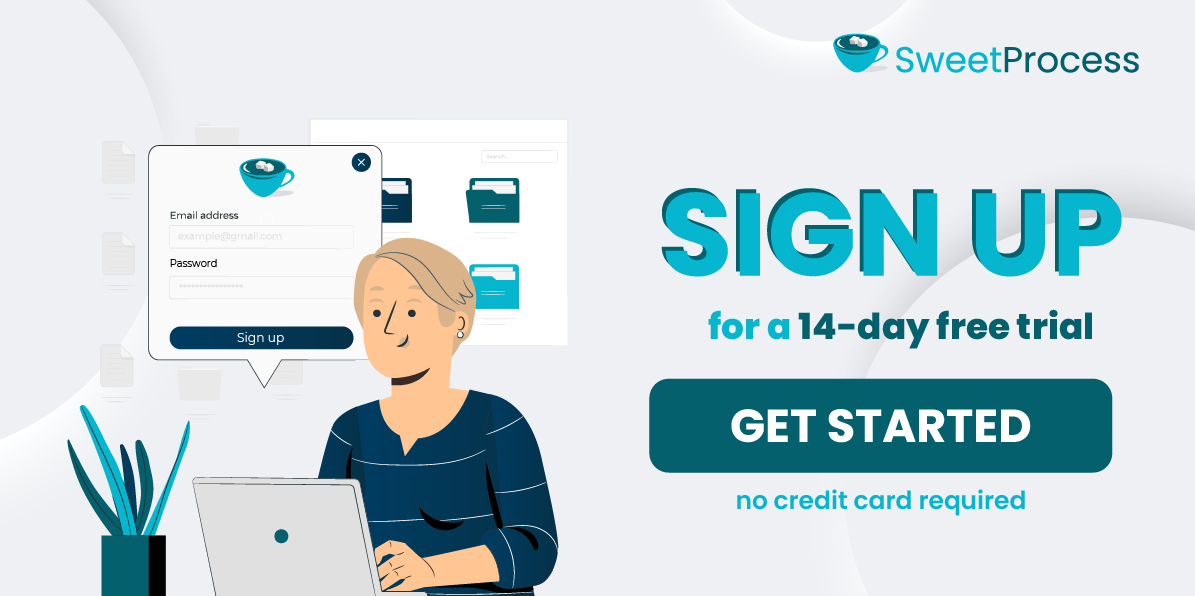Last Updated on October 30, 2025 by Owen McGab Enaohwo
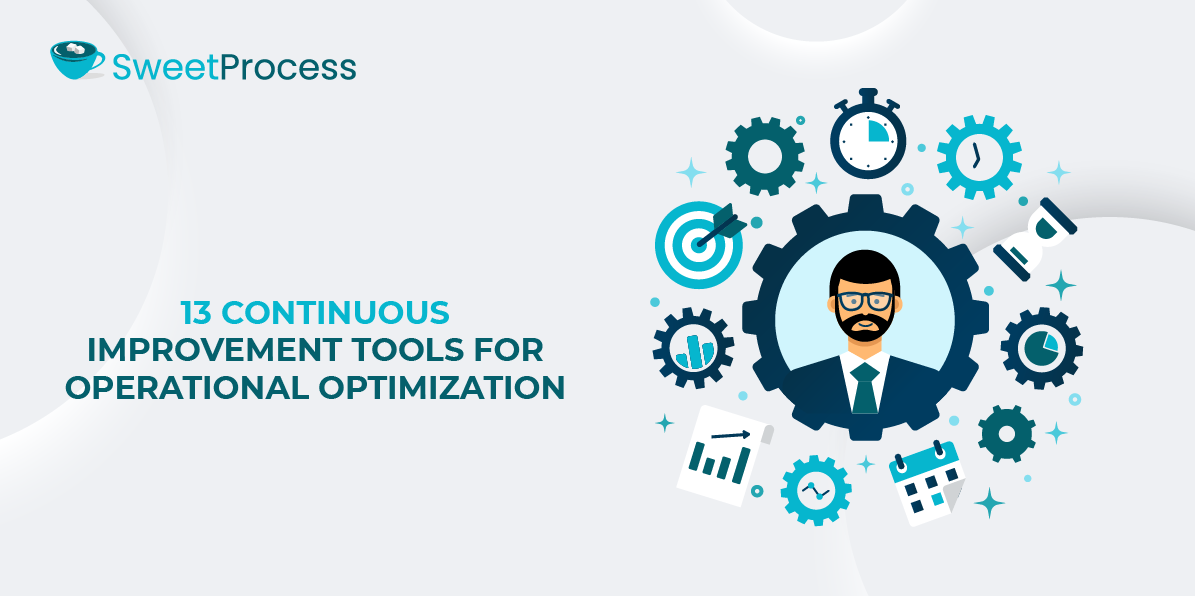
Are you chasing quarterly targets, juggling daily issues, facing redundant processes, and grappling with unmotivated teams? These are common challenges founders or team leaders face. It is no wonder that growing a business without an evolving system to support it can feel unproductive, especially if you put in effort.
Research by the Taylor and Francis group indicates that top-performing organizations adopt continuous improvement frameworks for promoting employee involvement. This system fosters team accountability, optimizes processes, and scales operations.
This resourceful guide breaks down the 13 most practical and proven continuous improvement tools.
Table of Contents
13 Continuous Improvement Tools for Small Businesses
9 Benefits of Continuous Improvement Tools for Your Company
How To Manage Your Company’s Continuous Improvement Using SweetProcess
Which Continuous Improvement Tool Should You Use for Your Company?
13 Continuous Improvement Tools for Small Businesses
Continuous improvement tools offer a wide range of software and methodologies built to eliminate inefficiencies that clog desired output and optimize and scale overall workflow and performance.
Neave Group Outdoor Solutions, a company that operates both in a B2C and B2B capacity with 125 full-time employees, grappled with the challenge of getting its staff on board to contribute to documenting and implementing their own procedures. With the SweetProcess effect, continuous improvement became the order of the day. Now that systems are optimized, current systems can get better, and bottlenecks are easily spotted, creating effective communication, seamless collaboration, and continuous workflow.
Now, let’s look at some of the most practical continuous improvement tools there are.
1. PDCA (Plan, Do, Check, Act)
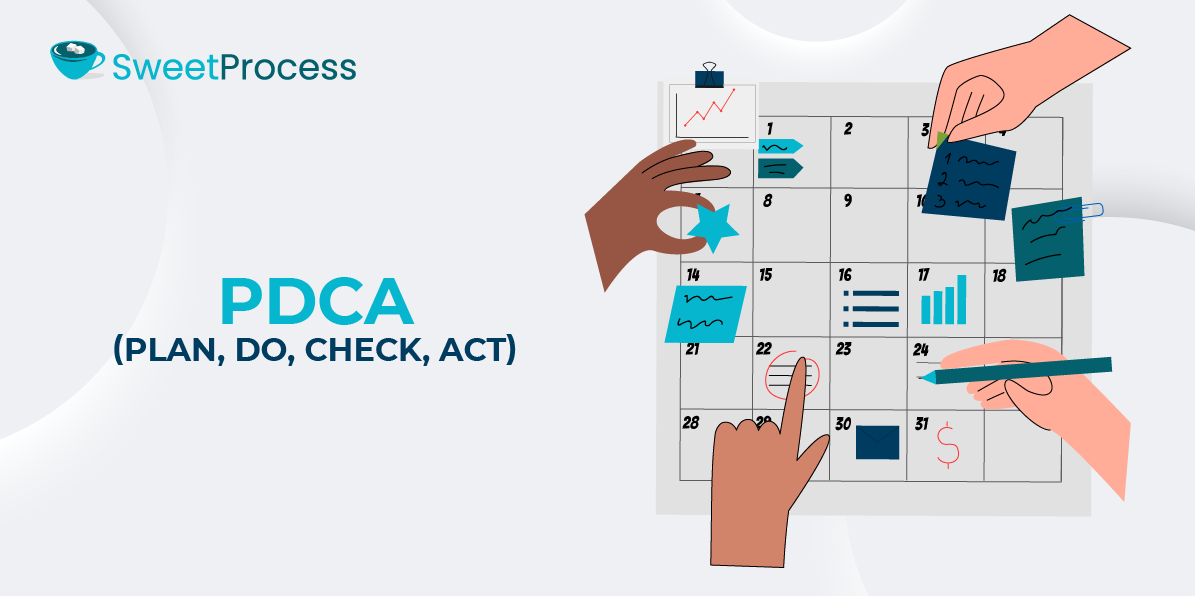
PDCA is one of the widely used, straight-to-the-point, and powerful approaches to testing and optimizing operations in business. PDCA, which stands for plan, do, check, and act, is a proven and tested four-step method that aids in standardization before full-scale implementation.
Benefits of PDCA
Fosters incremental improvements without major hitches
The PDCA continuous improvement technique fosters a culture of team management in small incremental steps.
Brings down the risk of costly changes
This continuous improvement tool for operational optimization does a great job of helping you reduce the time and money wasted on changes that don’t work.
Promotes a continuous feedback and learning culture
PDCA offers the opportunity for ongoing improvements that empower teams and help them refine and grow smarter over time.
How To Apply PDCA as a Small Business
As a founder, you apply the PDCA continuous improvement technique by first planning to change all inefficient processes. The idea is to unclog all the wheels. Then, execute the test, review the results, and finally repeat the workflow.
2. Gemba Walk
The gemba walk method is a Japanese term meaning “the real place.” This continuous improvement tool involves team leaders, managers, and business owners capturing and observing day-to-day workflows and operations to understand how processes work at a deeper level.
Benefits of Gemba Walk
Exposes invisible bottlenecks in reports
Gemba walk functions by taking you directly to the existing source of the problem rather than relying on reports and dashboards that sometimes give inaccurate data.
Identifies improvement opportunities
This continuous improvement tool helps employees feel heard, enabling managers to gain an in-depth understanding of what’s working and the challenges.
Fosters Smarter Improvements
Gemba walks help you spot and track workflow challenges, breakdowns, and inefficiencies, which are based on reality and not assumptions.
How To Apply Gemba Walk as a Small Business
To incorporate gemba walks into your small business, start by selecting a specific area or process to observe. This means you need to be at the workspace regularly to interact with team members. Thereafter, document your insights using SweetProcess and follow through with continuous visible improvements to build trust and drive meaningful change.
3. Kanban
Kanban is a potent continuous improvement tool for tracking workflows. The visual system with this technique tracks progress with a digital or physical board. This makes progress tracking real and visible, thereby reducing overload. This continuous improvement tool helps you track how your team executes tasks and workflows.
Benefits of Kanban
Promotes transparent and manageable workflows
The kanban tool provides a visual overview of work progress, including who’s working on what and what tasks are currently in progress.
Helps limit unnecessary activities
This tool helps reduce unnecessary workloads that waste valuable time. Kanban empowers teams to set limits on the number of tasks that can be in progress at once.
Improves team communication and task accountability
Teams that communicate often without leaving any cracks or relying on micromanagement achieve more, and this is the value the kanban tool fosters.
How To Apply Kanban as a Small Business
One of the best ways to apply the Kanban tool is by using tools like SweetProcess to create visual boards for recurring tasks such as process and procedure documentation, customer support, or inventory management. SweetProcess empowers your team to set and manage work according to how it’s being done.
4. Five Whys
The five whys borders on the root cause analysis method, which helps dive into deep-level symptoms and uncover why there are problems in the first place. This means that just as the name suggests, you ask “why?” consistently, typically around five times, until you encounter the big issue.
Benefits of Five Whys
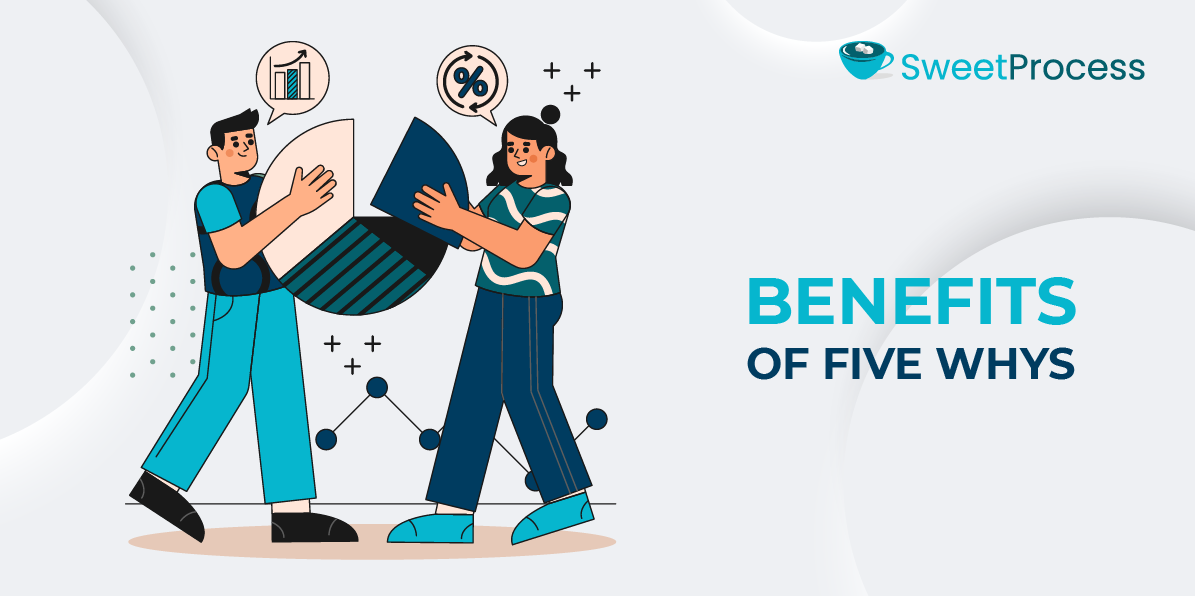
Identify systemic issues
This tool gives you and your team the luxury of uncovering issues that go deeper rather than treating symptoms.
Swift and Coherent Results
This tool is simple, inexpensive, and it doesn’t require technical skills to apply. The five whys can be conducted in a team conversation or meeting.
Helps To Eliminate Recurring Hitches
One of the frustrations of business is having recurring problems that can’t be eliminated. This tool pinpoints and addresses the true root cause so that you avoid making the same mistake twice.
How To Apply the Five Whys as a Small Business
You can make the most of this tool as a team leader or small business owner by gathering relevant team members and starting to ask “why?” The key is to keep pushing until you reach a cause that points to a broken process or missing system, not just human error. To standardize this, consider documenting the chain of “why” answers as you detect the root cause in SweetProcess.
5. Root Cause Analysis
Root Cause Analysis (RCA) is a deep, structured, systematic method for tracking symptoms and underlying causes of a problem. Unlike the five whys approach, which is a conversational tool, RCA delves even deeper using systemic methods such as the fishbone diagram (Ishikawa), fault tree analysis, or Pareto analysis to visually map and analyze the different causes contributing to an issue.
Benefits of Root Cause Analysis
Leaf symptoms to treat the root cause
This continuous improvement tool doesn’t just put out fires—it identifies what fuels the problem, thereby addressing it at the source.
Fosters data-driven choices
The root cause analysis method helps support measurable data, team input, and structured problem-solving tools.
Promotes long-term fixes over quick patches
RCA gives you the opportunity for results beyond just an emergency respite. This tool helps you to design solutions that permanently eliminate and improve workflow.
How To Apply Root Cause Analysis as a Small Business
Apply this method by identifying errors in the workflow or processes. This is especially helpful when the problem is a recurring one. This enables the team to gather relevant data and use a visual tool, such as the fishbone diagram, to categorize potential causes. Investigate and ask targeted questions, test assumptions, and narrow down the true root causes.
6. Kaizen
Kaizen is a Japanese term meaning “change for the better.” It thrives on a philosophy of continuous incremental improvement. This tool offers a solution that doesn’t overhaul an entire process or launch changes, but promotes small, consistent improvements led by the employees who work directly on it.
Benefits of Kaizen
Empowers teams to improve their workflows
Kaizen isn’t just a method; it’s a mindset that amplifies employees’ voices. Frontline team members take ownership, suggesting improvements, testing them, and implementing what works. To support this continuous growth, tools like an employee training generator can streamline skill development, making it easier for teams to adapt and apply new ideas effectively.
Eliminates the resistance that comes with change
Kaizen eliminates the fear of change because employees are involved in the gradual change process, which allays their fears. There’s less fear, disorganization, or resentment.
Optimizes efficiency without high costs
With Kaizen, you don’t require massive investments or outside consultants. This is because most improvements involve tweaking and fine-tuning existing workflows, removing redundancies.
How To Apply Kaizen as a Small Business
Start by creating a physical or digital space where employees can regularly submit improvement ideas. You may consider a shared SweetProcess workflow labeled “Kaizen Suggestions.” Next, teach your team to identify steps that can be eliminated, tasks that could be automated, or communication gaps that can be closed.
7. Value Stream Mapping
Value Stream Mapping (VSM) is a reliable visual tool that helps you map out every step in a continuous improvement process, from the first customer interaction to the final delivery of a product or service. This provides a clear bird’s-eye view of how materials, tasks, information, and decisions flow through your system.
Benefits of Value Stream Mapping
Pinpoints delays, waste, and redundancy
VSM makes hitches, wastes, and repetitive tasks immediately visible. This way, you’re able to see where time, effort, or resources are being wasted.
Backups cross-functional improvement
This method is key to helping teams map the value they bring across multiple departments and promotes role collaboration.
Promotes customer satisfaction through faster delivery
VSM fosters leaner and efficiently coordinated products and services, which in turn makes room for faster delivery and more reliability.
How To Apply Value Stream Mapping as a Small Business

First things first: select a business process that your revenue or customer experience depends on. This could be your sales-to-fulfilment pipeline, support resolution flow, or product delivery system. Then design a leaner version of the process and use SweetProcess to document the optimized workflow, assign responsibilities, and train your team on the updated system.
8. Poka-Yoke
Poka-yoke is yet another Japanese term, this one meaning “mistake-proofing,” and it’s a continuous improvement method mainly focused on preventing errors before they happen. This means that it doesn’t stop at identifying the hitches, but goes further into preventing them. Poka-yoke is all about designing systems, tools, or workflows that make it either impossible or extremely difficult for mistakes to occur.
Benefits of Poka-Yoke
Reduces costly human errors
This method automatically removes the reliance on memory, judgment, or constant supervision because the poka-yoke system is engineered to catch or prevent mistakes early.
Consistency in routine operations is guaranteed
This method consistently delivers a seamless outcome, regardless of the task or process.
Enhances safety and compliance
The poka-yoke technique reduces noncompliance with safety and legal systems, preventing violations such as missing safety checks, skipping steps, or entering incorrect data.
How To Apply Poka-Yoke as a Small Business
Begin by identifying areas where workflow hitches and lapses occur, such as missed steps in the onboarding process, incorrect order entries, or other lapses. Consider identifying those errors in the process by creating mandatory fields in digital forms or simple checklists that employees must complete before moving to the next step.
9. Bottleneck Analysis
The bottleneck analysis is one of the most effective continuous improvement techniques. It is the practice of spotting and troubleshooting the slowest or most overloaded part of a process that causes a jam. This involves identifying areas where work accumulates, errors that hinder workflow, time wastage, capacity reduction, or frustrated team members.
Benefits of Bottleneck Analysis
Identifies capacity limits and crude workflows
This tool reveals exactly where work is jammed, just like a traffic jam. It helps you understand exactly what the challenge is.
Improves overall throughput
The bottleneck analysis eliminates the slowest step in your process and allows the rest of your operations to move faster.
Helps prioritize where to invest time or budget
One benefit of this tool is its ability to help you channel your energy and investment into the area that will have the highest impact.
How To Apply Bottleneck Analysis as a Small Business
Apply the bottleneck analysis method utilizing SweetProcess to optimize your workflow. Start by tracking your process performance for up to 14 days, and select a key workflow that you can monitor. Next, look for patterns where there are hitches as well as tasks that waste time and cause redundancy.
Start your 14-day trial for free without a credit card.
10. 5S Method
The 5S method is a proven continuous improvement tool that originated from the lean manufacturing industry. The 5S stands for sort, set in order, shine, standardize, and sustain, fostering efficiency, reducing clutter, and promoting team productivity.
The 5S method typically focuses on creating a perfect work environment where everything has its place and unnecessary items are removed, and systems are easy to maintain.
Benefits of the 5S Method
Fosters safety, speed, and quality
This method empowers teams to keep spaces clean and organized so that employees are less likely to face hazards, waste time searching for tools or files, or make mistakes.
Reduces time waste and clutter
Removing all the clogs in the wheel of the process in the workplace is what this tool offers. It removes unnecessary tools, documents, or steps that create confusion and slow teams down.
Fosters discipline and consistency in processes
Nothing drives continuous improvement like consistency, and this technique helps you do just that.
How To Apply the 5S Method as a Small Business
Apply this to your standard operating procedures (SOPs) as you standardize your outdated processes. Begin by choosing one area of focus; this could be your stockroom, workbench, front desk, or even your company’s shared cloud drive. Next, apply each “s” by first sorting and removing unnecessary items or files that are not used regularly or no longer serve a clear purpose.
11. Total Quality Management (TQM)
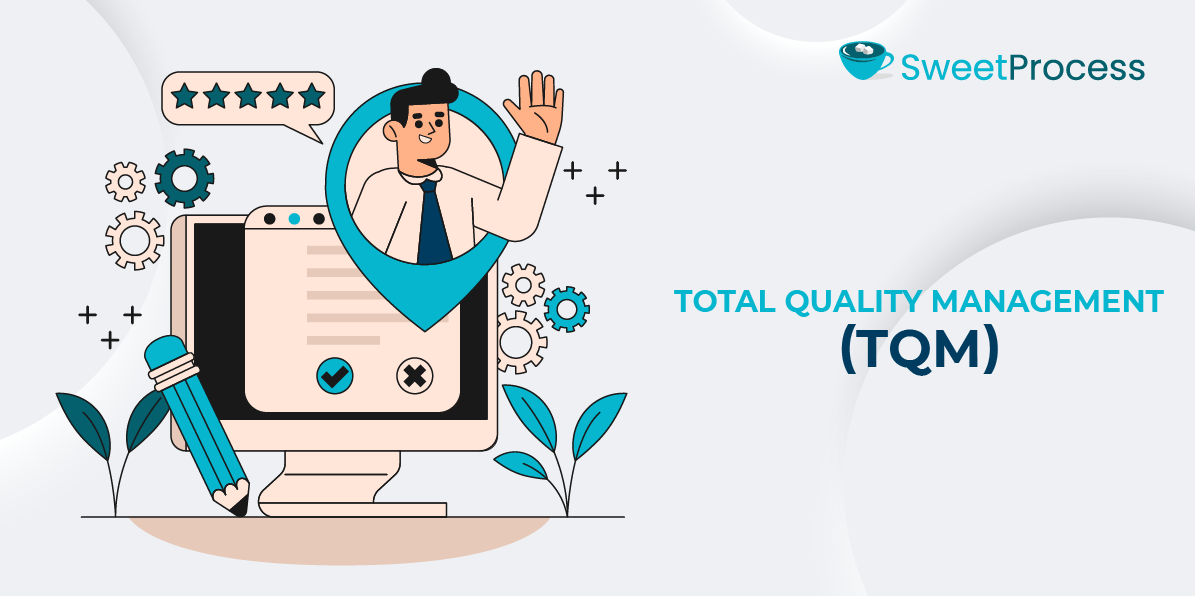
Total Quality Management (TQM) is an efficient strategy for promoting quality in every layer of your business. This isn’t a checklist or one-time project but a continuous improvement method that helps your team deliver improved services. TQM fosters a long-term mindset shift that prioritizes customer satisfaction, team collaboration, and process excellence as shared, everyday responsibilities.
Benefits of Total Quality Management (TQM)
Promotes a culture of collaboration across teams and departments
This method breaks down cumbersome processes and silos by encouraging every team to maintain an optimized quality.
Improves customer trust and loyalty
This tool helps build consistency that paves the way for high-quality experiences, which lead to loyalty.
Fosters employee accountability and ownership
TQM encourages employees to take ownership of both their role and the outcomes of their work.
How To Apply TQM as a Small Business
Consider starting by defining to your team what “quality” means in the context of your business. Would this mean faster delivery, fewer product defects, or clearer communication? After this, consider using SweetProcess to document and utilize the built-in tools, such as procedures, checklists, and quizzes, to ensure everyone adheres to the same high standards.
12. Lean Manufacturing
The Lean Manufacturing method of continuous improvement is a proven management philosophy that originated from Toyota’s large-scale production environments. It delves into delivering maximum value to businesses that manage physical inventory, deliver services, or are trying to scale their business.
Benefits of Lean Manufacturing
Eliminates unnecessary steps, costs, and delays
This method helps you eliminate processes that don’t add value. This means overproduction and excess inventory in double-entry tasks or unnecessary approval.
Optimizes time and other resources
The lean continuous improvement technique helps you avoid doing unnecessary work and instead encourages you to focus on doing only what the customer wants.
Fosters puts the focus on high-impact tasks
Lean’s ability to simplify workflows and remove waste helps to free up your team to focus on high-impact tasks.
How To Apply Lean Manufacturing as a Small Business
You get the most from the lean manufacturing method by first spotting and mapping out a key workflow. After that, evaluate every step using the seven wastes of lean, which are: overproduction, waiting, unnecessary transport, overprocessing, excess inventory, unnecessary motion, and defects. Identify which ones are necessary, and then streamline the process using SweetProcess to document the new version and ensure everyone follows the steps and knows what to do.
13. Business Process Management (BPM)
Business Process Management (BPM) is a continuous improvement method that identifies, improves, and manages processes that boost your business. It focuses on mapping out how work flows across teams, improving it for efficiency, and continuously monitoring performance. Although BPM is often associated with large enterprises, it serves small businesses well, especially those needing to scale and optimize across operations.
Benefits of Business Process Management (BPM)
Offers a bird’s-eye view into how work flows across the business
BPM is a continuous improvement tool that gives you full access to exactly how tasks move from one person or department to another.
Fosters agility in operations, especially during growth phases
The BPM framework helps to create and handle workflows without chaos. This makes it easy to scale smoothly and handle the pressures that come with growth.
Eradicates errors and inconsistencies by standardizing workflows
This method ensures that procedures are in place and everyone knows exactly how to perform a task. This technique guarantees minimal risk of missed steps, rework, or confusion.
How To Apply BPM as a Small Business
You can apply BPM as a continuous improvement tool by choosing core processes that impact your bottom line or customer experience. Thereafter, use SweetProcess to systematize those workflows by breaking each process into clear procedures, assigning responsibilities, and building task tracking.
9 Benefits of Continuous Improvement Tools for Your Company
Businesses like XL.net that use SweetProcess to systematize their workflow are more likely to succeed than those that don’t use continuous improvement tools. For almost a decade, the team documented 2,500 policies and procedures, but they now found that there was a lot of negative feedback from the services they provided to customers. With SweetProcess, processes and policies were now actively managed, and the results that came with it were fantastic.
Here are nine powerful pros your business can tap into when you apply continuous improvement to your business:
Operational Efficiency
Continuous improvement tools typically help you reduce the risk of redundancy in tasks. It also clarifies responsibilities and reduces time lost due to confusion, disorganization, or manual processes.
Enhanced Employee Engagement

This method helps team members engage and contribute ideas that are implemented. Tools like SweetProcess create a structure where every employee and manager can contribute to process improvement. Optiable, a law firm management company, used SweetProcess to enhance employee engagement and commitment, which brought change.
Reduced Waste
Waste in business comes in many forms, such as unused inventory, unnecessary steps, recurring work, or even unused knowledge. Continuous improvement methods, such as lean and value stream mapping, help you detect and reduce the risk of inefficiencies.
Cost Reduction
Continuous improvement tools help make minimal waste, fewer reworks, fewer inefficiencies, lower costs, and lower expenditures a reality. So whether it’s less employee overtime or fewer customer refunds, continuous improvement turns out to promote real savings that compound over time.
Improved Quality
Continuous improvement suggests that quality isn’t just about the product—it’s about consistency, reliability, and delivering on your promise to the customer. Process improvement tools like TQM and root cause analysis allow you to identify and fix quality gaps early.
Increased Profits

Better processes for continuous improvement tools lower costs and promote better output, which improves your profit margins, optimizes how you operate, and helps you reinvest more in growth instead of patching problems or covering losses.
Increased Customer Satisfaction
Continuous improvement fosters swift service, precise communication, and reliable outcomes, which are by-products of great internal processes. When your workflows are digitized and run optimally, customers notice, and they stay loyal.
Fostering Innovation
Continuous improvement tools encourage small experiments and regular reflection, which makes it easier to test new ideas, learn from failures, and implement what works. This creates a system of proactive teams that are problem-solvers instead of passive executors.
Creating a Continuous Workflow
Continuous improvement tools create an unending flow that helps you build systems that evolve. Rather than constantly starting from scratch or chasing updates, you are empowered to develop a workflow that supports brisk momentum across departments as your business scales.
How To Manage Your Company’s Continuous Improvement Using SweetProcess
SweetProcess is a continuous improvement platform that helps you optimize work consistently. So, whether you are getting started, managing a growing team, trying to systemize chaotic workflows, or simply grappling with being more consistent in business, SweetProcess turns your operational knowledge into living, evolving systems.
When businesses explore different tools, they often struggle with finding one that balances simplicity and scalability. That’s where SweetProcess stands out—it provides a structured way to document procedures, assign tasks, and monitor progress, ensuring that improvements are not just ideas but implemented practices.
By incorporating the use of continuous improvement software like SweetProcess, companies can streamline processes, enhance collaboration, and maintain a culture of ongoing development across all departments.
Let’s look at how SweetProcess supports continuous improvement.
Document Repetitive Tasks in One Place
Documenting repetitive tasks efficiently poses a serious challenge for most companies. Also, employees may make mistakes due to misinterpretations or a lack of knowledge, which leads to rework, customer dissatisfaction, and potential financial losses. SweetProcess helps you to streamline your business processes and create a system that can easily be operated by anyone.
Here is a step-by-step tutorial to guide you on documenting repetitive tasks with SweetProcess.
Step One
Log in to your SweetProcess account and click on the “Procedures” tab.

Step Two
Next add the procedure title.

Step Three
Add this procedure to a particular team or multiple teams.

Step Four
Add the description of the procedure.
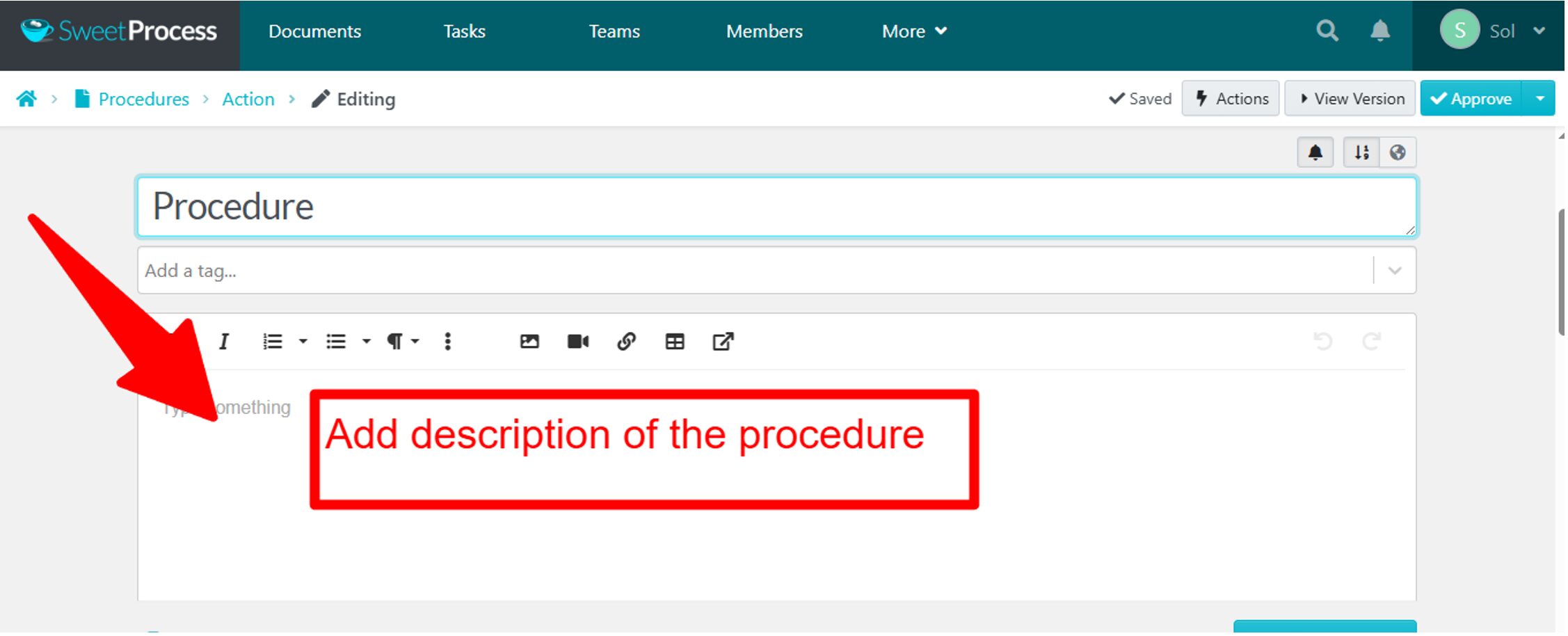
Step Five
Now it’s time to add tags using keywords. This is to make it easy for you to identify or find your procedure.

Step Six
Tap the “Step” button to edit your steps.

Step Seven
Here, you will include a title and description for your step. You can embed images and videos or add a link to the step.
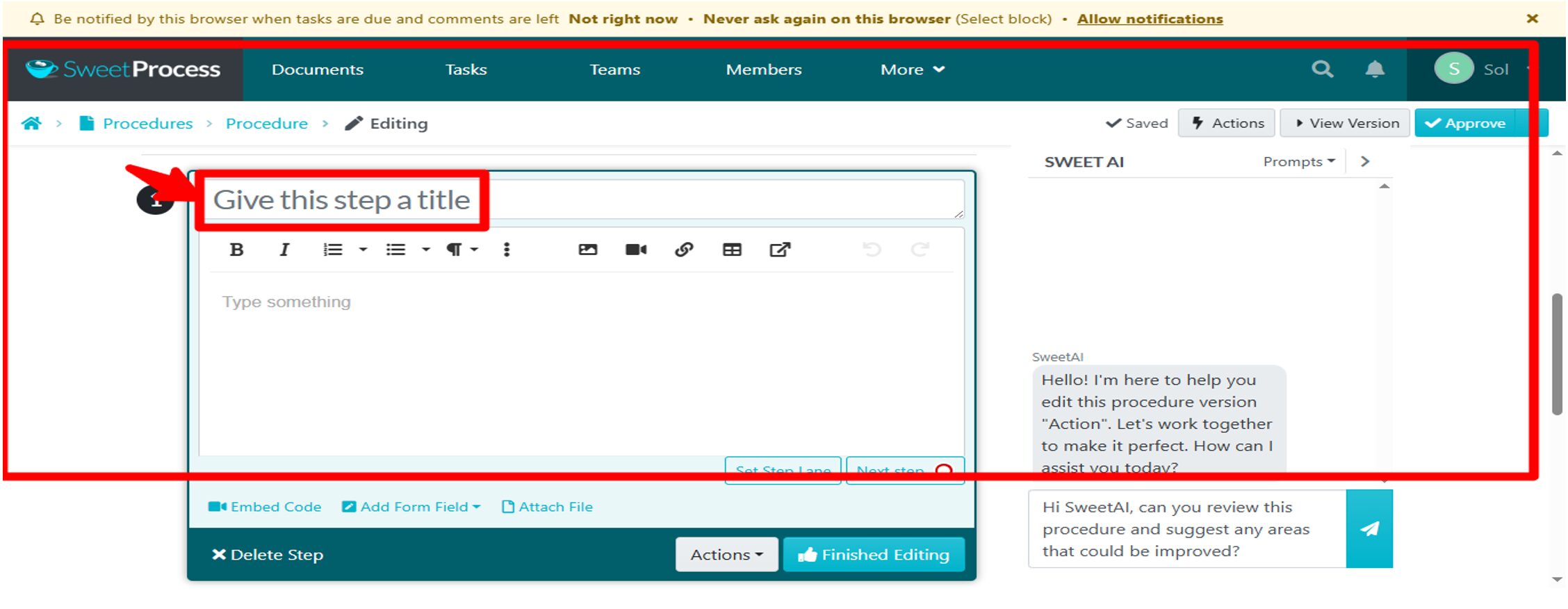
Click “Finish Editing,” and if you decide to add more steps, follow the same procedure until you’ve added all the necessary information. Then tap the “Approve” button, and your procedure will be live on SweetProcess.

Turn Procedures and Processes Into Actionable Tasks
Your business can experience a range of negative consequences when procedures and processes cannot be translated into actionable tasks. Your team could waste their time and resources, experience decreased efficiency, and experience a decline in overall performance. SweetProcess empowers you to turn processes and procedures into actionable steps that create clarity, excellent documentation, and continuous improvement.
Here is how SweetProcess helps with turning procedures and processes into actionable steps.
Step One
To assign, open the list of processes and click the three dots to the right of the process to be assigned.

Step Two
Next, navigate to the documented procedure list to assign a procedure as a task.

Step Three
Click the three dots to the right of the procedure to be assigned.

Step Four
Click “Assign” and select the team member to carry out the task for either the process or procedure. Add the due date, reminder, and then complete the process.
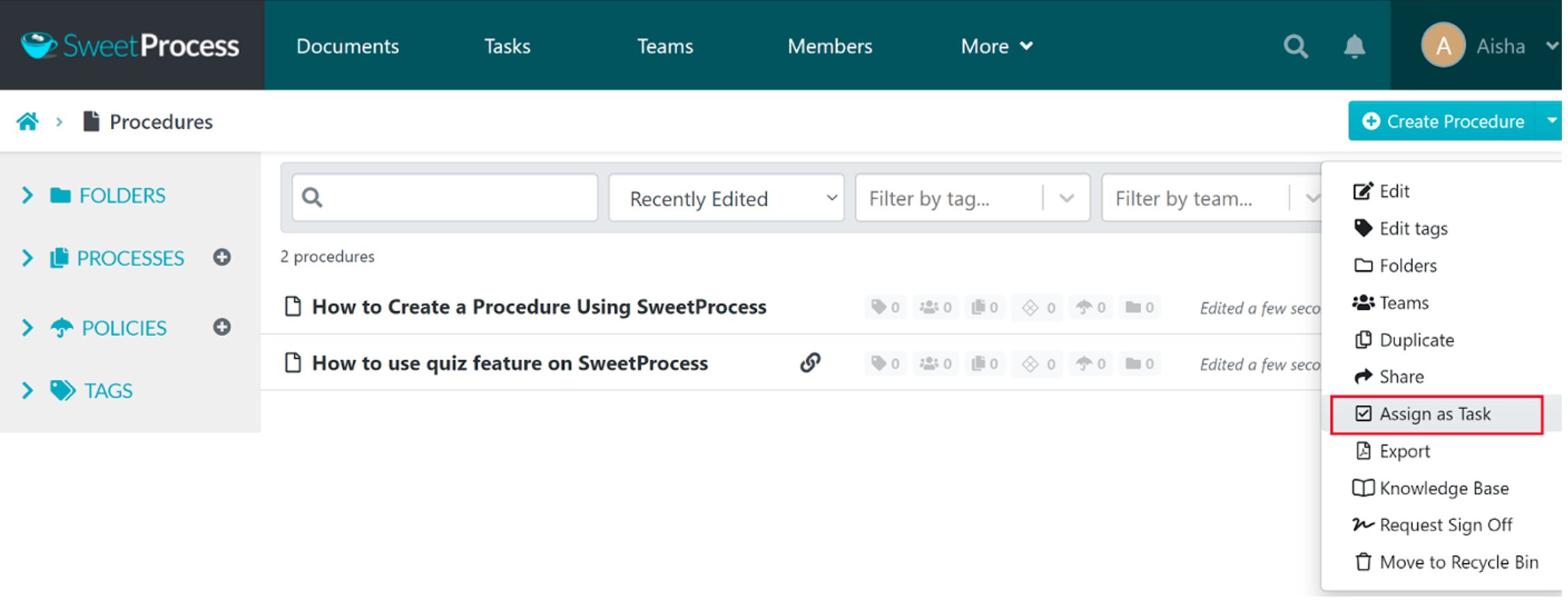
Note that tasks can also be assigned directly from the procedure while it is open. You can do this from the “Actions” menu on the top right of the screen below:
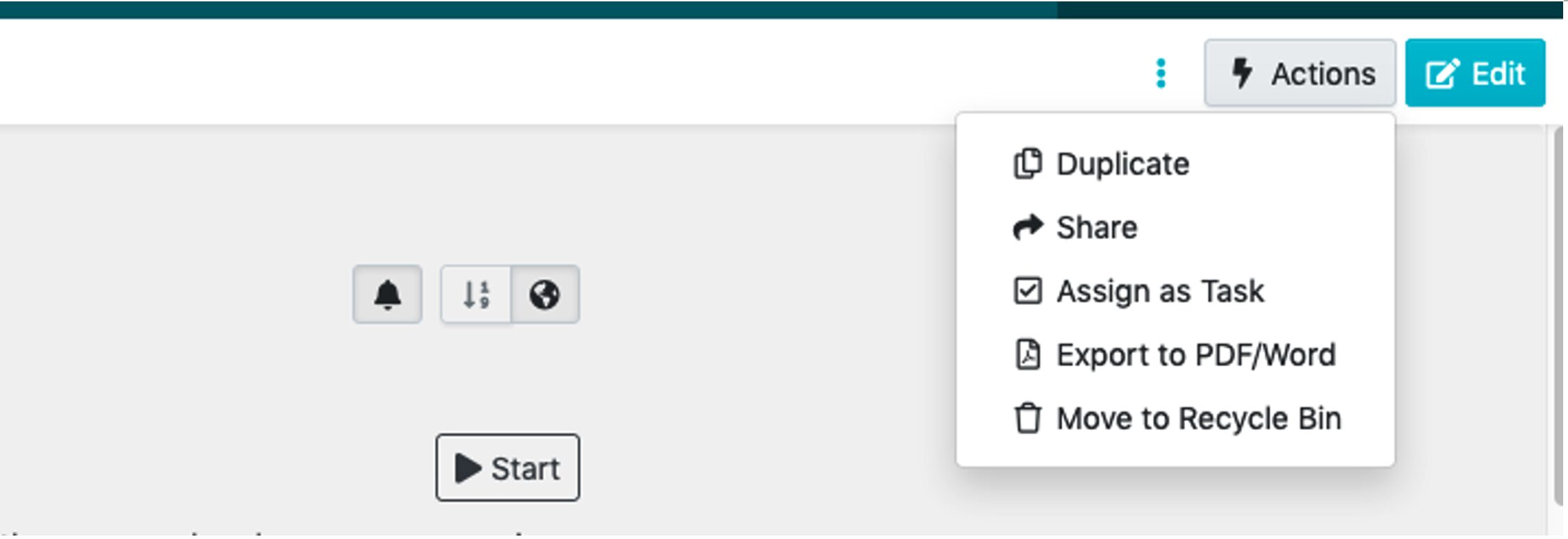
What’s more, once assigned, a notification of tasks assigned is sent to a single team member or an entire team.
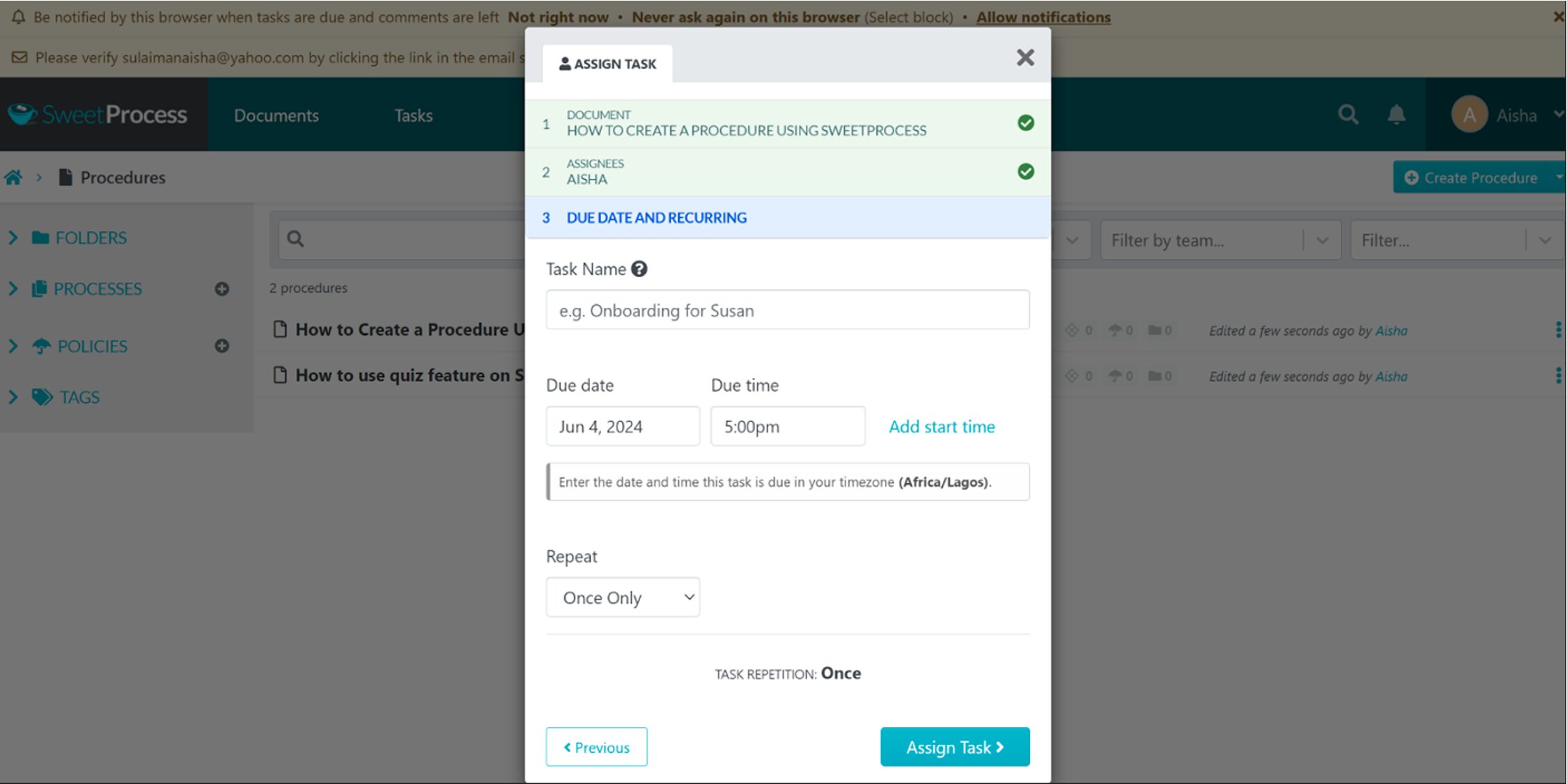
The Emazing Group is a B2C company in the e-commerce space with 60 employees. It was unable to organize all its processes in one convenient, central location until it embraced SweetProcess. This powerhouse of continuous business improvement empowered them to improve the efficiency of their training and hiring process, as well as centralize their processes.
Build a Quiz To Assess Your Team’s Grasp of Company Policies, Processes, and Procedures

Susceptibility to increased risk, decreased productivity, and higher employee turnover are some of the downsides of operating your business without assessing your team’s understanding of company policies, processes, and procedures through quizzes. Having a knowledge check helps you identify areas where employees are struggling and provide targeted training to improve their understanding and performance.
Here is how to build a quiz to assess your team’s understanding of company policies, processes and procedures with SweetProcess.
Step One
Click the “More” drop-down and then click on “Quizzes.”

Step Two
A new page will pop up; click the “Create Quiz” button, which redirects you to the section below.

Step Three
Click the “Create Quiz” button; you will be redirected to the section where you can add a title to create your quizzes.

Step Four
Next click “Add to teams.”


Step Five
In this section, you can provide the quiz description and set a duration for it.
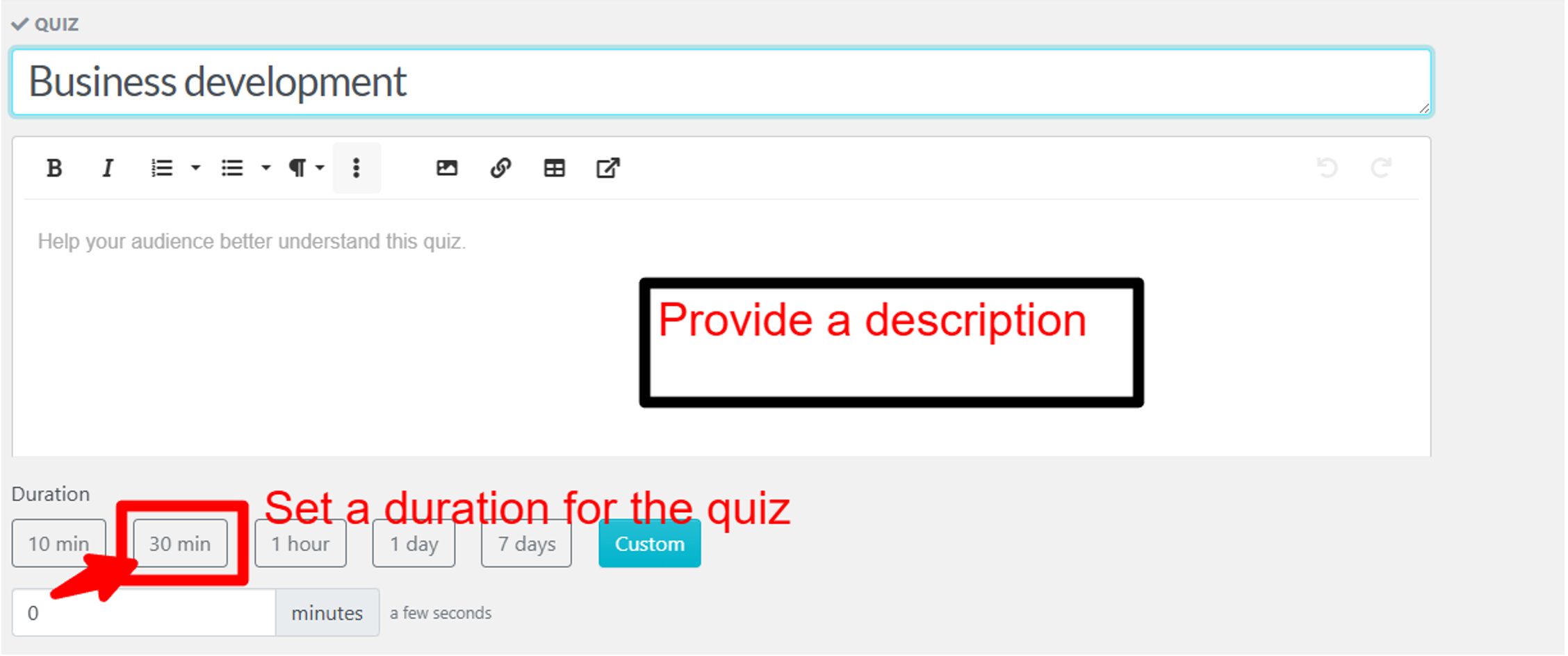
Step Six
Set a pass mark for the quiz.

Step Seven
Add recommended documents and set up the quiz.

Once done, this is what it should look like:

Turn Existing Procedures and Policies Into a Beautiful Knowledge Base
A knowledge base helps to centralize information, reduce errors, streamline onboarding, boost overall productivity, and make it readily accessible to everyone.
This is how to turn your existing procedures and policies into a beautiful knowledge base using SweetProcess.
Step One
Click on the “More” dashboard link to reveal a drop-down menu.

Step Two
Click on the “Knowledge Bases” button.
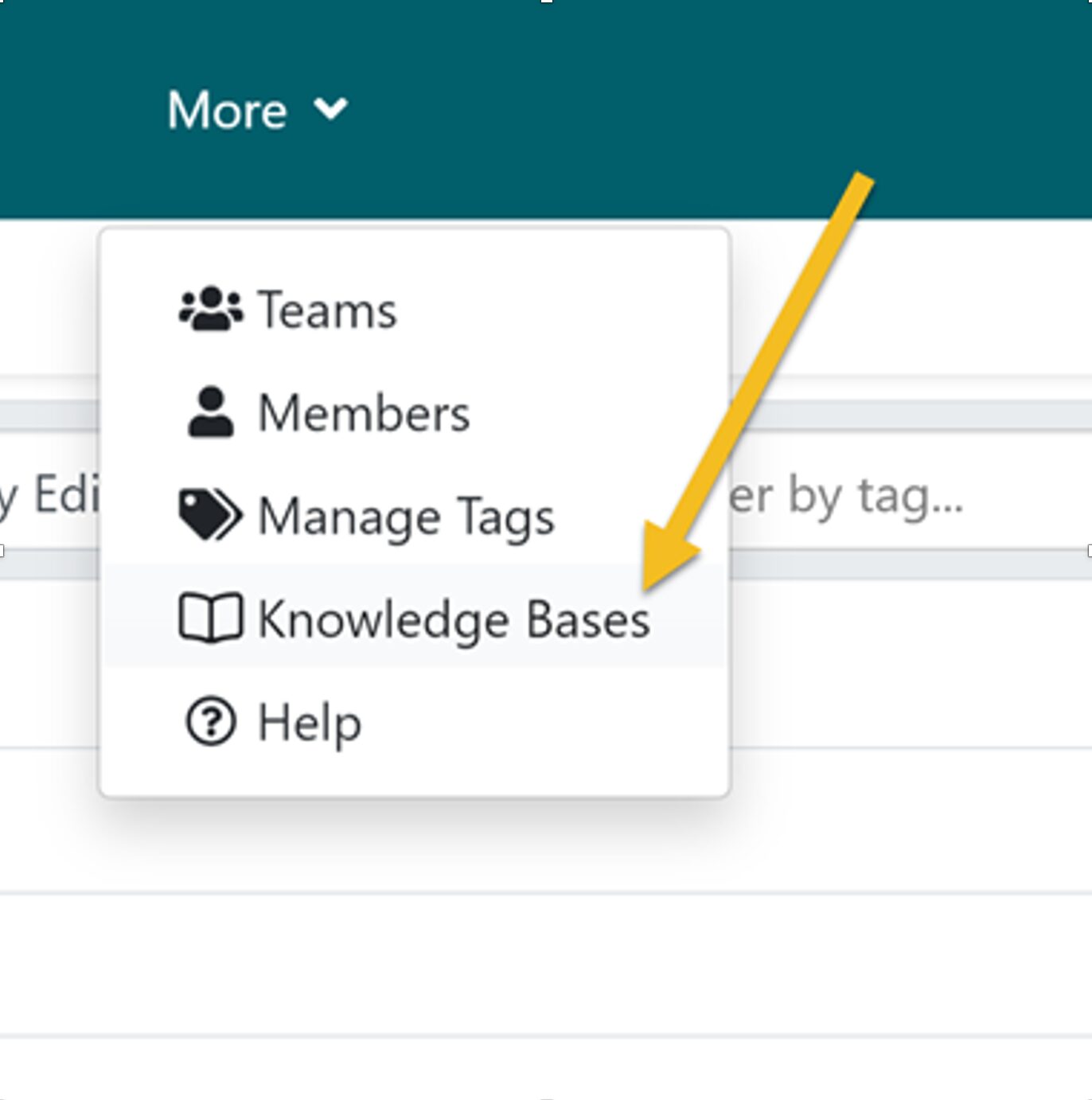
Step Three
Once the new page loads, click the “Create Knowledge Base” button.

Step Four
Enter the title of your knowledge base and click the “Continue” button.

Manage Procedures, Processes, and Policies
As your company grows and your quest to scale heightens, your operational complexity increases. If there isn’t a centralized system, things can spiral into confusion. This is why SweetProcess is a must-have continuous improvement tool to navigate the challenges of managing procedures, processes, and policies.
Procedures
SweetProcess simplifies your workflow by helping to document each procedure in clear, actionable steps. This includes screenshots, videos, or checklists, and makes it easy to assign them to team members. Your procedures can be linked to larger processes or reused across multiple workflows.
IMS ExpertServices, a consultative firm that caters to the world’s most influential law firms, was navigating through hard-to-use systems as well as a hard tribal knowledge problem among teams. It switched to SweetProcess, and now they have moved from processes scattered all around to streamlining them for optimal performance.
Processes
Your processes are a sequence of tasks or activities that produce a specific outcome, such as the processes for your full employee onboarding or product fulfillment pipeline. SweetProcess can help you group multiple procedures into one seamless process.
Policies
Policies, which are company rules, standards, or guidelines, govern and shape behavior or decisions, such as HR policies, security protocols, or time-off rules. SweetProcess promotes storing and managing all your company policies in one secure location.
Automate with SweetAI
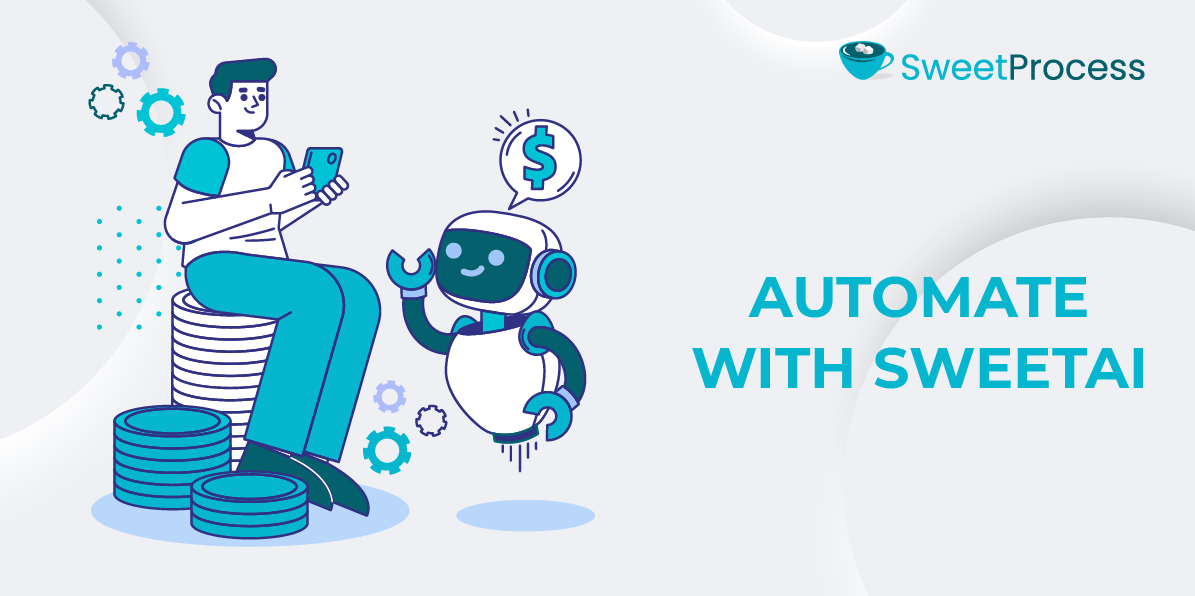
You can automate the creation of SOPs with SweetAI. Achieve a whole lot with the SweetProcess AI, a system built into the SweetProcess platform to draft new procedures, update existing ones, and polish policies until they sound like your own work. SweetAI assists and drafts for better organization. By assigning a topic, SweetAI can create a logically organized SOP with accurate and precise steps.
Here is how you can create a process with SweetAI:
Step One
Select the “More” menu in your SweetProcess workspace and click “Procedures.”
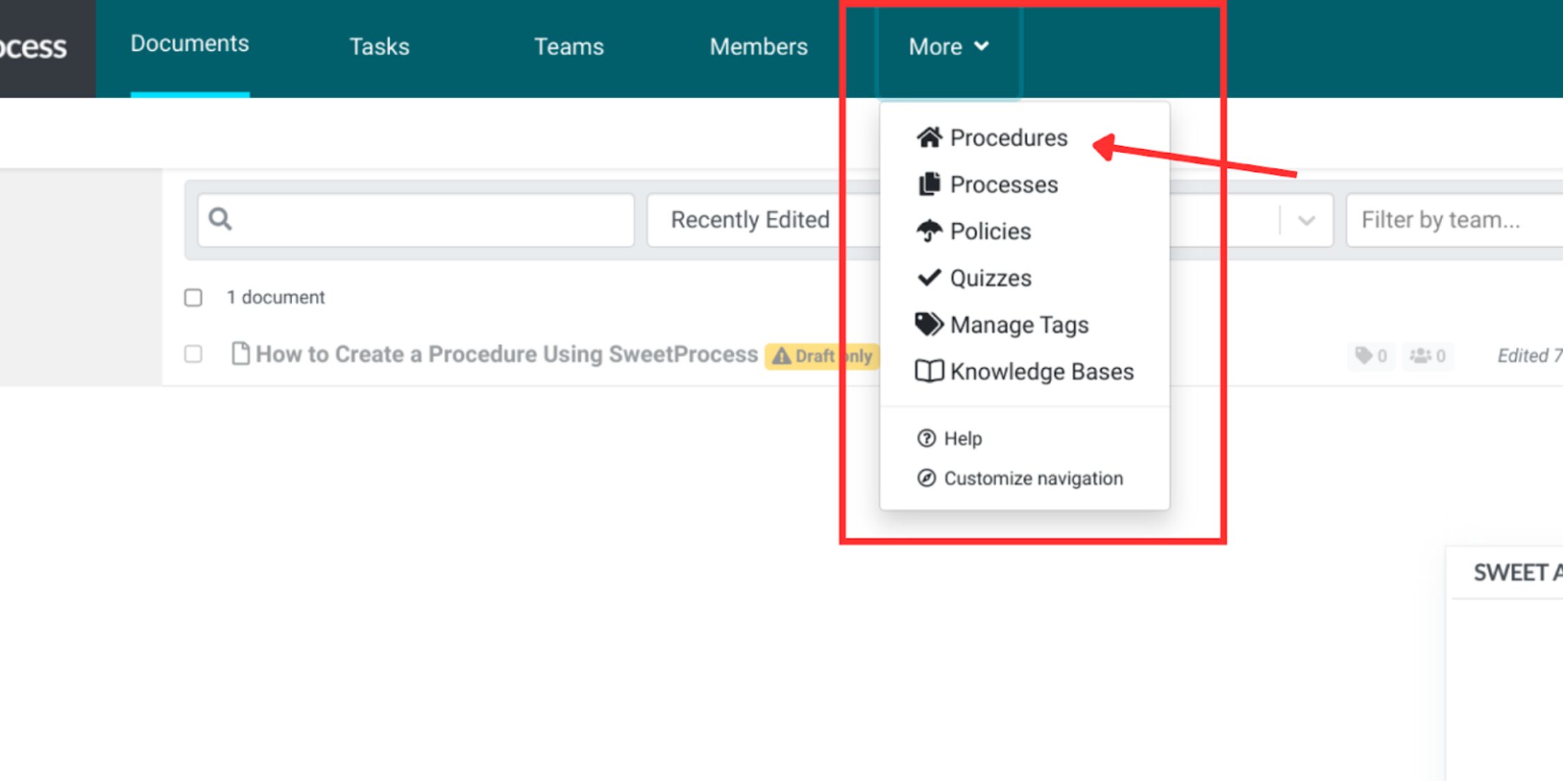
Step Two
Open “Create Procedure” in the top-right corner to open up a new document.

Step Three
Add your title.

Step Four
Click “Write with SweetAI” and watch what happens.

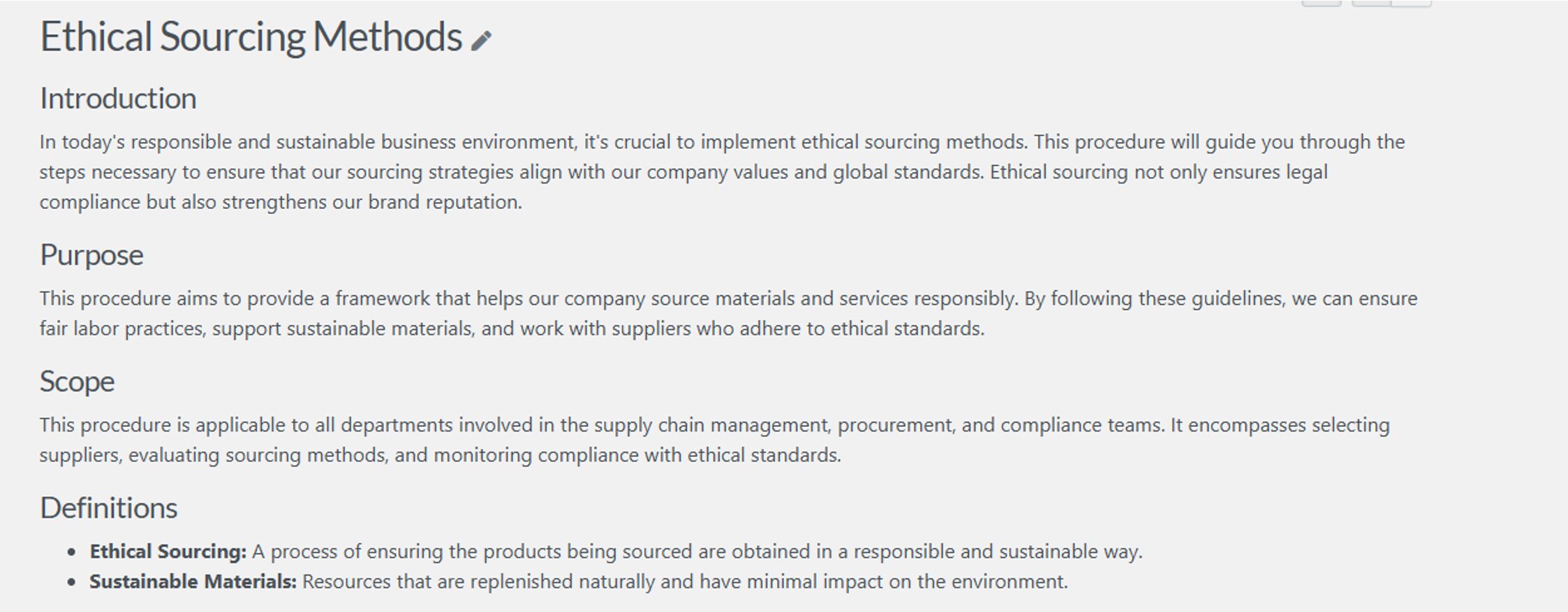
Step Five
Review and adjust to add a step or remove one that doesn’t apply.
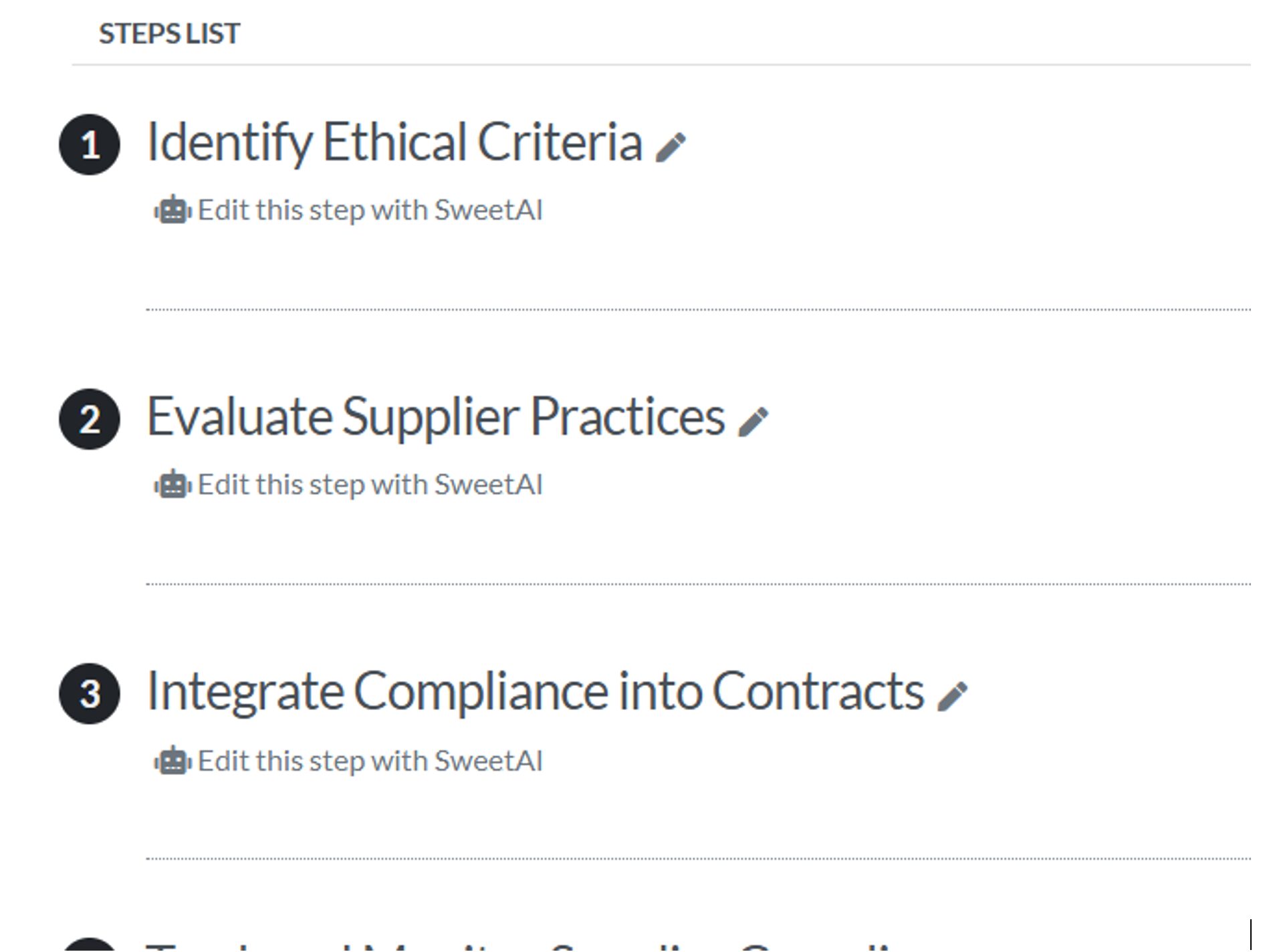
Finally, select “Approve” on the top right to finish your procedure. Make sure to save it to your procedure library so that collaboration and assigning to members for feedback is easy. You can also turn each step into a task with deadlines and reminders.
Which Continuous Improvement Tool Should You Use for Your Company?
Continuous improvement with SweetProcess helps you build an operational engine for your business that drives growth and makes scaling less cumbersome. So, whatever level you are in business, adopt SweetProcess to build a system that gets smarter over time.
